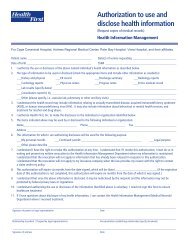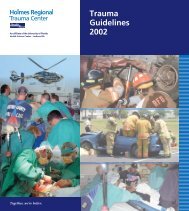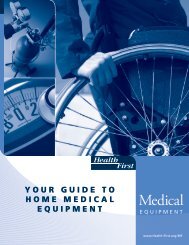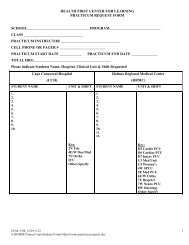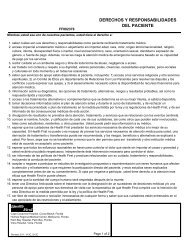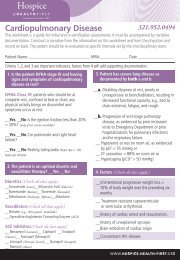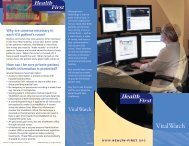Read the Wall Street Journal article featuring VitalWatch - Health First
Read the Wall Street Journal article featuring VitalWatch - Health First
Read the Wall Street Journal article featuring VitalWatch - Health First
You also want an ePaper? Increase the reach of your titles
YUMPU automatically turns print PDFs into web optimized ePapers that Google loves.
THE WALL STREET JOURNALTuesday, October 27, 2009The Picture of <strong>Health</strong>With critical-care specialists in short supply, remote monitoring offers a high-tech solutionBy LAURA LANDROBleeding heavily after an emergency C-section last year, Jennifer Gale ended up in <strong>the</strong>intensive-care unit at Holmes Hospital in Melbourne, Fla. Throughout <strong>the</strong> night, <strong>the</strong> critical-carespecialist on duty closely watched her vital signs, ordering additional units of blood until hercondition stabilized.But <strong>the</strong> doctor wasn't at her bedside—or even in <strong>the</strong> hospital. Working from a command centerin a nearby office building, he was remotely monitoring her and o<strong>the</strong>r patients in six intensivecareunits in three different hospitals operated by Rockledge, Fla.-based health system <strong>Health</strong><strong>First</strong>. The monitoring system, known as an eICU, uses two-way video cameras and softwarethat tracks patients' vital signs and instantly registers any changes in lab test results or physicalcondition. That enables doctors in <strong>the</strong> command center to spot early warning signs that a patientis taking a turn for <strong>the</strong> worse, advise bedside staff on giving medications and treatments, andpoint out potential errors or oversights.Ms. Gale, 31, a high-school teacher and volleyball coach, says learning that a specialist wasmanning <strong>the</strong> eICU helped reassure her when she was frightened and distraught at beingseparated from her newborn. "I know he was watching me all night long," she says. "I really felt Iwas getting <strong>the</strong> kind of care I might not have received o<strong>the</strong>rwise."Far and NearRemote monitoring is offering a high-tech solution to <strong>the</strong> vexing problem facing a growingnumber of hospitals: how to care for <strong>the</strong> sickest patients amid a worsening shortage ofintensivists, <strong>the</strong> critical-care specialists trained in caring for life-threatening injuries or illnesses.Studies show that mortality rates are 30% to 40% lower in hospitals where intensivists areproviding round-<strong>the</strong>-clock care to prevent complications and minimize errors, but only about athird of patients in <strong>the</strong> ICU today receive care from an intensivist. The federal Department of<strong>Health</strong> and Human Services projects that demand for intensivists will continue to be greaterthan available supply in <strong>the</strong> next three decades.The Leapfrog group, a large coalition of employers that sets safety and quality standards, in2000 included round-<strong>the</strong>-clock intensivist staffing as one of three standards it uses to determinewhere employees should go for hospital care. But with only 31% of hospitals able to meet <strong>the</strong>criteria, <strong>the</strong> group says remote monitoring is one way to shift <strong>the</strong> balance. While an intensivistworking in a hospital may oversee 10 patient beds, one doctor and four nurses in a remotecommand center can oversee <strong>the</strong> care of 75 to 100 patients.The leading provider of such systems, 11-year-old Visicu, was acquired last year by electronicsgiant Philips Electronics NV, and says that it now supplies <strong>the</strong> technology to 42 health systemscovering 5,900 beds—about 10% of <strong>the</strong> nation's ICU beds. The systems cost $4 million to $5million on average to install, and can cost $2 million more annually to staff and maintain. But
hospitals that have used <strong>the</strong> systems say <strong>the</strong>y soon pay for <strong>the</strong>mselves in reduced costs,mortality and length of stay in <strong>the</strong> ICU. While <strong>the</strong>y are especially useful in smaller communitiesand rural areas where about 35% of America's hospitals are located, <strong>the</strong>y have also beenshown to improve care and reduce mortality in large urban academic medical centers, where<strong>the</strong> remote doctors using monitoring programs can catch things that may be missed even by atrained eye in a well-staffed ICU.Fast Response"From a remote center, doctors are able to respond to computer-based alerts [and] identifywhen a patient is beginning to get into trouble, as opposed to when <strong>the</strong>y are already in trouble,"says Brian Rosenfeld, chief medical officer of Baltimore-based Philips Visicu and one of <strong>the</strong> twoformer Johns Hopkins University intensivists who developed <strong>the</strong> system. For example, <strong>the</strong>software can identify when a patient's heart rate is too high for a particular condition, which adoctor or nurse at <strong>the</strong> bedside might not immediately recognize. And <strong>the</strong> software can identifysigns of a deadly infection such as sepsis in a patient before <strong>the</strong> symptoms might be obvious. Inaddition to monitoring patient conditions, an eICU system triggers reminders when, for example,a central line has been left in a patient for more than 96 hours and needs to be removed toprevent infection.At <strong>the</strong> University of Massachusetts Medical Center, a study of 6,400 patients in seven adultintensive-care units monitored by eICU showed substantial benefits in reducing both costs andmortality, according to <strong>the</strong> hospital's director, Craig Lilly. After <strong>the</strong> costs of <strong>the</strong> system werefactored in, <strong>the</strong> hospital was able to save $5,000 per case, Dr. Lilly says, in large part because<strong>the</strong> system enabled intensivists in <strong>the</strong> remote command center to "detect instability and bringnew treatment to <strong>the</strong> patient before <strong>the</strong>y would have received it in a regular ICU." Over a sixmonthperiod, <strong>the</strong>re were more than 30,000 interventions in <strong>the</strong> ICU, 24,000 of <strong>the</strong>m involving achanged treatment plan or new diagnosis. Dr. Lilly says 199 of <strong>the</strong> interventions were made at<strong>the</strong> request or suggestion of <strong>the</strong> offsite monitoring team for every one made at <strong>the</strong> request of <strong>the</strong>bedside team.An eICU clinical operations room at Inova <strong>Health</strong> System in Falls Church, Va., is equipped with two-wayaudio and videoDr. Lilly is now working on a study of <strong>the</strong> benefits of remote monitoring for community hospitals,with funding from <strong>the</strong> New England <strong>Health</strong>care Institute, based in Cambridge, Mass. "Thebrilliance isn't <strong>the</strong> technology, but <strong>the</strong> fact that we can use <strong>the</strong> technology to help physicianspractice evidence-based medicine," says Wendy Everett, president of <strong>the</strong> nonprofit group. ButMs. Everett says <strong>the</strong>re is still resistance to <strong>the</strong> idea of remote monitoring; medical directors atsome large hospitals her group interviewed said <strong>the</strong>y weren't considering <strong>the</strong> technology
ecause <strong>the</strong>y didn't think <strong>the</strong>re was any room for improvement in <strong>the</strong>ir ICUs. And intensivistswho have worked with <strong>the</strong> systems say <strong>the</strong>y can't be effective unless those at <strong>the</strong> bedside arewilling to take direction from <strong>the</strong> remote monitors and work as a team, which isn't always <strong>the</strong>case.Convert in FloridaJames Shaffer, medical director of <strong>the</strong> eICU at <strong>Health</strong> <strong>First</strong> in Florida, says at first he resisted<strong>the</strong> idea of using <strong>the</strong> technology, because he worried it would "rob <strong>the</strong> human element of care."But with <strong>the</strong> hospital group growing rapidly and adding a fourth hospital, it didn't have <strong>the</strong> staff tocover its existing six intensive-care units adequately, especially at night, Dr. Shaffer says. Now,he and o<strong>the</strong>r intensivists alternate bedside care with night-shift duty in <strong>the</strong> eICU."I feel so gratified when I walk out of a night <strong>the</strong>re—it's like a giant pinball machine that lets mestomp out all <strong>the</strong>se fires," Dr. Shaffer says. "I'm not just one guy trying to be too many places atonce."In addition to cutting costs, hospitals say <strong>the</strong> eICU can actually help <strong>the</strong>m increase revenue.Since St. Mary's Hospital in Jefferson City, Mo., began outsourcing electronic monitoring of itsICU to St. Louis-based Advanced ICU Care, shorter lengths of stay have allowed St. Mary's totake on more patients in <strong>the</strong> ICU, and increase its revenue by $1.2 million in <strong>the</strong> first two years.Sioux Falls, S.D.-based Avera <strong>Health</strong> System uses its eICU system to cover 72 intensive-carebeds in 18 hospitals spread over a five-state region, some as many as 350 miles apart. Prior tousing <strong>the</strong> system, it had just two hospitals with intensivists. "Now we are able to put a virtualnurse and intensivist at every bedside in our system, continually," says Chief Quality OfficerDavid Kapaska. In addition to catching warnings that o<strong>the</strong>rwise might go unheeded, intensivistscan quickly determine if a procedure such as placing a central line must be performed, <strong>the</strong>nmobilize hospital staff on site and move on to <strong>the</strong> next patient issue. "You can't physically be inall those places at once but you can know what is going on in all of <strong>the</strong>m at <strong>the</strong> same time,"says Dr. Kapaska.Saving Lives and MoneyAt Avera hospitals, ICU mortality has been 65% to 80% lower than predicted by a ratings scaleused to measure how well patients will fare once <strong>the</strong>y arrive in <strong>the</strong> unit; before <strong>the</strong> eICU wasadopted, <strong>the</strong> average rating for <strong>the</strong> group was 50% lower than <strong>the</strong> predicted rate. That hastranslated into about 400 lives saved, according to Ed Zawada, <strong>the</strong> eICU medical director forAvera. The system has also enabled smaller hospitals to keep sicker patients instead oftransporting <strong>the</strong>m to bigger medical centers.In a study comparing results before and 30 months after implementation of <strong>the</strong> system, ruralhospitals in <strong>the</strong> network estimated a 37.5% reduction in <strong>the</strong> number of patients requiring transferto a larger hospital, saving more than $1.2 million; reduced length of stay in <strong>the</strong> ICU saved anestimated $8 million, <strong>the</strong> study showed.Janet Doom, a 74-year-old patient recovering from heart surgery, was being transferred from asmaller Avera hospital to <strong>the</strong> group's main McKennan Hospital in Sioux Falls, after she began tofeel ill. But a blizzard hit, making <strong>the</strong> roads impassable, so she had to be admitted to a smallrural medical center operated by Avera. Monitored for three days by <strong>the</strong> staff in <strong>the</strong> eICU, sherecalls overhearing <strong>the</strong> conversations about her care.
"They knew everything, including my heart rate, my pulse, and how much pain I was in," saysMs. Doom. "When you need something like that, it's nice to know it's <strong>the</strong>re."— Ms. Landro is an assistant managing editor for The <strong>Wall</strong> <strong>Street</strong> <strong>Journal</strong> and writes <strong>the</strong> paper's InformedPatient column. She can be reached at laura.landro@wsj.com.






